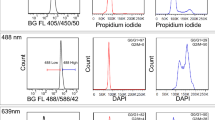Abstract
Estimation of the repartition of asynchronous cells in the cell cycle can be explained by two hypotheses:
-
- the cells are supposed to be distributed into three groups: cells with a 2c DNA content (G0/1 phase), cells with a 4c DNA content (G2+M phase) and cells with a DNA content ranging from 2c to 4c (S phase);
-
- there is a linear relationship between the amount of fluorescence emitted by the fluorescent probe which reveals the DNA and the DNA content.
According to these hypotheses, the cell cycle can be represented by the following equation:
All the solutions for this equation are approximations. Non parametric methods (or graphical methods: rectangle, peak reflect) only use one or two phase(s) of the cell cycle, the remaining phase(s) being estimated by exclusion. In parametric methods (Dean & Jett, Baisch II, Fried), the DNAT(x) distribution is supposed to be known and is composed of two gaussians (representative of G0/1 and G2+M) and a P(x,y) function representative of S phase. Despite the generality, these models are not applicable to all sample types, particularly heterogeneous cell populations with various DNA content. In addition, the cell cycle is dependent on several regulation points (transition from quiescence to proliferation, DNA synthesis initiation, mitosis induction) and biological perturbations can also lead to cytokinesis perturbations.
Before the emergence of flow cytometry, the current view of cell cycle resided in the assessment of cell proliferation (increase in cell number) or the kinetic of molecules incorporation (DNA precursors). The widespread development of flow cytometry has revealed the concept of cell cycle distribution and this snapshot distribution required methods to analyze this new information; this aspect led to the notion of cell cycle Mathematical Modeling.
Similar content being viewed by others
References
Baisch, H., W. Gohde & W.A. Linden (1975). Mathematical analysis of pulse-cytophotometric data to determine the fraction of cells in the various phases of cell cycle. Radiat. Environ. Biophys. 12: 31.
Baisch, H. & H.P. Beck (1978). Comparison of cell kinetics parameters obtained by flow cytometry and autoradiography. In: A.J. Valleron & P.D.M. McDonald, eds. Biomathematics and Cell Kinetics. Amsterdam, Elsevier/North Holland Biomedical Press, 411–422.
Barlogie, B., B. Drewinko, D.A. Johnston, T. Buchner, W.H. Hauss & E.J. Freidreich (1976). Pulse cytophotometric analysis of synchronized cells in vitro. Cancer Res. 36: 1176.
Barrett, J.C. (1964). A mathematical model of the mitotic cycle and its application to the interpretation of percentage labeled mitoses data. J. Natl. Cancer Inst. 37: 443.
Christensen, I., N.R. Hartmann, N. Keiding, J.K. Larsen, H. Noer & L. Vindelov (1978). Statistical analysis of DNA distribution from cell populations with partial synchrony. In: D. Lutz, ed., Pulse Cytophotometry III. Gent, European Press, p. 71–78.
Fox, M.H. (1980). A model for computer analysis of synchronous DNA distributions obtained by flow cytometry. Cytometry 71: 25.
Fried, J. (1976). Method for the quantitative evaluation of data from flow microfluorometry. Comp. Biomed. Res. 9: 263.
Friteau, L., P. Jaffray, X. Ronot & M. Adolphe (1988). Differential effect of D-penicillamine on the cell kinetic parameters of various normal and transformed cellular types. J. Cell. Physiol. 136: 514.
Kendall, D.G. (1948). On the role of variable generation time in the development of a stochastic birth process. Biometrika 35: 316.
Kerker, M., M.A. van Dilla, A. Brunsting, J.P. Kratohvil, P. Hsu, D.S. Wang, J.W. Gray & Langlois, R.G. (1982). Is the central dogma of flow cytometry true: That fluorescence intensity is proportional to cellular dye content? 3: 71.
Krsihan, A. & E. Frei (1976). Effect of Adriamycin on the cell cycle traverse and kinetics of cultured human lymphoblasts. Cancer Res. 36: 143.
Okuda, A. & S. Cooper (1989). The continuum model: an experimental and theoretical challenge to the G1 model of cell cycle regulation. Exp. Cell. Res. 185: 1.
Pierrez, J. & A. Guerci (1988). Les modélisations mathématiques. In: P. Métézeau, X. Ronot, G. Le Noan Merdrignac & M.H. Ratinaud, eds., La Cytométrie en Flux. Paris, Medsi/McGraw-Hill, p. 31–40.
Ronot, X., C. Hecquet, S. Larno, B. Hainque & M. Adolphe (1986). G2 arrest, binucleation, and singleparameter DNA flow cytometric analysis. Cytometry 7: 286.
Author information
Authors and Affiliations
Rights and permissions
About this article
Cite this article
Pierrez, J., Ronot, X. Flow cytometric analysis of the cell cycle: Mathematical modeling and biological interpretation. Acta Biotheor 40, 131–137 (1992). https://doi.org/10.1007/BF00168142
Published:
Issue Date:
DOI: https://doi.org/10.1007/BF00168142




